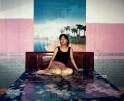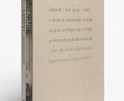Photographers on Photographers: Conner Gordon in Conversation with Gregory Halpern
There are images of place, and then there are images about place. All photographs have to be made somewhere, yet the way photographers incorporate this layer of information could not be more varied. For some, conveying a sense of place is the central purpose for the work; for others, it is a concern secondary to, or even distracting from, other narrative or conceptual goals. Yet some of the best photographs manage to thread the needle between these approaches, allowing place to inform the work without reducing it to an expression of geography alone.
Nowhere is this interplay better expressed than in the work of Gregory Halpern. I first encountered Halpern’s photographs in ZZYZX, a kaleidoscope of a book where Halpern’s images of Los Angeles highlight narratives of precarity, improvisation, desire, and the sublime. While the photographs felt deeply tied to their geography, their narrative and metaphorical weight also managed to transcend it, leaving a profound impact on me as I was beginning my artistic practice.
Nearly a decade later, and as my photobook collection has grown to fill a repurposed library cart, there are precious few books that have recaptured that initial sense of wonder. But when I first turned through the pages of Halpern’s latest book (King, Queen, Knave, published by MACK), I felt that familiar electricity return. Halpern’s images of his hometown of Buffalo swap out the harsh clarity of ZZYZX’s Los Angeles for the light-pollution-meets-snowy-skies of upstate New York, revealing scenes that feel both eerily specific and impossible to pin down. It was a privilege to speak with Halpern about this work, his creative practice, and his thoughts on the relation between photographs and the places they are made.

Gregory Halpern (b. 1977, Buffalo, NY) has published a number of books, including A (2011), East of the Sun, West of the Moon (2014), a collaboration with Ahndraya Parlato, ZZYZX (2016), Confederate Moons (2018), and Omaha Sketchbook (2019). He also edited, with Jason Fulford, The Photographer’s Playbook: Over 250 Assignments and Ideas (2014). He holds a BA in History and Literature from Harvard University and an MFA from California College of the Arts, and in 2014 he was the recipient of a Guggenheim Fellowship. He teaches photography at the Rochester Institute of Technology and is a member of Magnum Photos.
Instagram: @gregoryhalpern
Instagram: @mack_publishing
Conner Gordon: Congratulations on the release of King, Queen, Knave! I’m interested in how your work about your hometown of Buffalo feels in comparison to some of your earlier projects, which have focused on places that may have not held that same degree of familiarity. Was undertaking this project any different for you in this regard?
Gregory Halpern: I started photographing in Buffalo twenty years ago, when I first started taking photography seriously. Since then, it’s always been in the background, a place I’d come back to many times a year, usually with my camera. So it was all much slower than my other projects. There was no urgency really, which was both helpful and sometimes not. I live in the region still, about an hour away, and over those years I added pictures here and there from the area.
It’s both easier and harder to make work at home. I know places and people, and sometimes It helps to be an “insider,” but the eyes also get dulled to it over time. An “outsider” sometimes comes in with fresh eyes and shows you something in a new way, or simply shows you something you’d forgotten was there. To be part insider, part outsider, is sometimes the ideal position to be in as a photographer.
Conner Gordon: I’m curious about how you think about a sense of place in your work. From Buffalo to Los Angeles to Omaha to Guadeloupe, your work is often made within a particular geography, which can suggest a sense of specificity about a place and what it represents. How do you think about the potential (or pitfalls) of making work that feels site-specific in this way? Are you interested in images that are unique to or descriptive of the place you’re working, or do you see your work as aiming for something more open-ended and abstract, with the place acting as a carrier for those ideas?
Gregory Halpern: I think both in some ways. I want to respond visually to each place in a way that feels unique to that place, or at least responsive to the details, histories, idiosyncrasies of the place. This might include the sense of light and color there, as well as more intangible things, like literature from the place that might inform how I think and feel about it. I think of it less as documenting a place but responding to what it offers, and to its sensibility.
Conner Gordon: It’s been really interesting to see your work in Buffalo evolve through the dual formats of the book (King, Queen, Knave) and the exhibition (19 winters / 7 springs). How do you think about the relationship between the book and the exhibition? In what ways does one inform the other, and how has your thinking about these intertwined formats changed over the course of your career?
Gregory Halpern: I used to think of an exhibition as an opportunity to put a book on the wall. But increasingly I’ve come to see the exhibition and the book as completely different forms, just pulled from the same material. The book is a more psychological experience, the exhibition a more physical experience. Since the book sequence is fixed, the experience you create for the reader must be intensely controlled. With an exhibition there is usually no way to determine how a viewer will move through it, what sequence they will view the work in, and what associations they will make. Entire walls can be taken in quite quickly, and nearly infinite relationships can quickly be formed. It’s overwhelming but also a bit freeing compared to bookmaking, and I wind up being more playful and experimental, in part because I know it’s not permanent and I’ll change it each time I show the work in a new space.
Conner Gordon: How do you think through the materiality of your work? I’m thinking not only of traditional questions of scale and framing, but also of your house sculptures in the exhibition of 19 winters / 7 springs, and the material choices of earlier projects, like the contact prints and light-faded construction paper of Omaha Sketchbook. Do you find that making those decisions is intuitive, or does it take a lot of hammering out to settle on the work’s final presentation?
Gregory Halpern: It’s intuitive, but then I often sit with those decisions a long time before I feel comfortable sharing them. I made the first house sculpture at least ten years before I showed it. I needed to feel good about it, and also to tweak it over time. Same with Omaha Sketchbook. I made the first sketchbook in 2004, but didn’t publish the book for twelve years. In terms of scale, it’s also pretty intuitive to determine what size works best for an image. Different sizes allow viewers to interact physically with the work in different ways, and they act on you differently. The large prints can sometimes feel like they wash over you, and the landscape surrounds you; the small prints, if they work, call out to you, and pull you into them.
Conner Gordon: I love this quote from you:
“It is said that photography is uniquely suited to ‘reflect’ the world around us, but what if our surroundings are complex to the point of being visually and verbally indescribable? That conundrum is the reality I want to reflect, with the creation of a rightfully impenetrable thing.”
I’m interested in similar questions of photography’s reputation for essentializing reality–this idea of the clarifying image or the decisive moment, and what new possibilities are created by photographs failing to live up to those promises. I’m wondering, then, how you think about photographic ambiguity, fiction, and other forms of “unreality” in your work?
Gregory Halpern: Photography really distorts the world, but it does so in such a way as to imply that it’s “reflecting” it or “capturing” it, which is misleading. Sometimes it can do that, but I tend to think that’s more rare than not. It’s a deceptive medium, which is one of the reasons it’s so compelling and powerful. For me, once I accept that the medium actually is better suited to ambiguity than actual clarity, I can be more honest about what I’m doing, and more free to use it how it feels right, at least to me. I’ve sometimes said I envy painting, because somehow it seems more honest, or at least less deceptive (or deceptively ambitious), about its intentions. It’s almost purely subjective, and we allow it that freedom. Photography is more closely related to fact somehow, although that relationship is nearly impossible to define, and is never fixed.
Conner Gordon: I’m interested in how you see your trajectory in relation to some of your first projects, such as Harvard Works Because We Do. I think it’s interesting that you began your career more firmly rooted in traditional documentary approaches, especially given that this is a common origin point for many photographers (myself included). In what ways do you see the legacy of those early approaches still influencing your practice?
Gregory Halpern: I still feel deeply inspired by some of the great, more traditional “documentary” photographers, like Milton Rogovin, Walker Evans, and Chris Killip, although Evans preferred the modifier “lyric” before using the word documentary, and Killip was clear that his work was highly subjective and even metaphorical. People are also products of their time, and Evans and Killip pushed against tradition in their own ways. It’s fascinating to follow that lineage to someone like Paul Graham, who is clearly influenced by people like Evans and Killip, but who then took the idea of documentary one step further with Shimmer, among other projects. I still think Killip’s In Flagrante (the original) is the best photobook ever made, certainly in the “documentary tradition.”
For me, making Harvard Works… was important, in that I spent enough time working on it (three years) to understand what goes into making a “documentary” like that. I also learned how to use photography to present a subjective vision as fact, which I’m no longer comfortable with. And so the project gave me something quite useful to push against in my later work. It also is at least partly responsible for how skeptical I am these days of including any text in my books.
Conner Gordon (b. 1994, USA) is an Oregon-based artist exploring photography as unreliable narration. His work has been exhibited at spaces including Solas Gallery in Seattle, WA, Ditch Projects in Springfield, OR, Blue Sky Gallery in Portland, OR, The Humid in Athens, GA, and Filter Space in Chicago, IL. He was a 2019-2020 Fulbright Research Grantee to Serbia, where he photographed the legacy of Yugoslav-era architecture. He received a BA in political science from DePauw University and holds an MFA in art from the University of Oregon. He has self-published three zines and will release his first book in 2025.
Instagram: @conner.gordon
Posts on Lenscratch may not be reproduced without the permission of the Lenscratch staff and the photographer.
Recommended
-
Aaron Rothman: The SierraDecember 18th, 2025
-
Photographers on Photographers: Congyu Liu in Conversation with Vân-Nhi NguyễnDecember 8th, 2025
-
Linda Foard Roberts: LamentNovember 25th, 2025
-
Arnold Newman Prize: C. Rose Smith: Scenes of Self: Redressing PatriarchyNovember 24th, 2025
-
Spotlight on the Photographic Arts Council Los AngelesNovember 23rd, 2025





























































